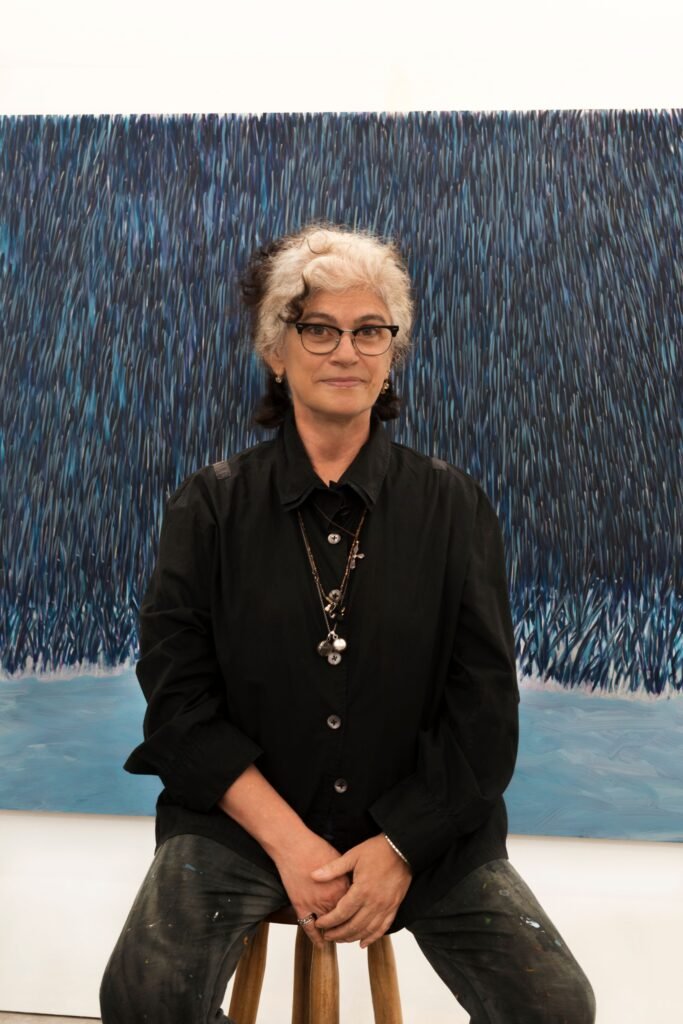Exhibition dates: 7 June–3 August 2024
Thomas Dane Gallery, 3 Duke Street, St James’s, London SW1Y
(Landscape of Legend) – the second exhibition at Thomas Dane Gallery in London by the renowned Brazilian artist Patricia Leite.
Born in Belo Horizonte, Brazil, in 1955, Patricia Leite’s artistic journey has been deeply influenced by the myths and legends of the Tupi-Guarani indigenous people. These narratives, which depict gods residing in the sun, moon, forest, sea, stars, and mountains, have profoundly shaped Leite’s worldview and artistic imagination since her childhood.
“Paisagem de Lenda” presents a collection of new paintings and a significant floor-based tapestry that draw upon these indigenous stories, intricately linked to Brazil’s diverse landscapes and ecology. As natural environments face threats from climate change, industrial activity, and neglectful governmental policies, Leite’s work serves as both a reflection on what is at risk and a melancholic celebration of what still endures.
Leite’s paintings are infused with personal stories and memories. In her studio, she often refers to each work by the origin of its reference image, such as “the sea, from my son” or “the trees, from my friend,” before it receives a formal title. Her process involves transforming pre-existing images—whether photographs or recollections—by modifying and expanding them with layers of memory and imagination. This technique results in artworks with a unique, iconic quality that seems distant from their original source, a characteristic noted by curator Rodrigo Moura.

One of the highlights of the exhibition is a collaboration with São Paulo-based Uruguayan tapestry maker Jorge Francisco Soto. Together, they have created Mumuru (por Burle Marx) (2024), a stunning floor tapestry inspired by the Amazon’s giant lily pads. The tapestry, shaped like a body of water, features intricate woven lily pads and flowers, rooted in the legend of the Mumuru. According to the tale, a young girl named Naiá, captivated by the moon goddess Jaci, dreamed of becoming a star. Her sacrifice was rewarded by Jaci, transforming her into a star that floats on water, memorialized as the Mumuru with fragrant white flowers that bloom at night.
Overlooking this tapestry is Jaci (2024), a panoramic nightscape painted with oil on wood. This piece reflects Leite’s ongoing fascination with the moon and the liminal moments between day and night. In this painting, the moon shines brightly against an indigo sky, casting deep green palm leaves into shadowy silhouettes.

Leite’s exploration of light and water—rainfall, sea, reflections, starlight, dusk, moonlight—permeates her work. In Glisten (2024), she depicts trees mirrored in a still body of water. Sideral (para Naiá) (2024) showcases a sky filled with shooting stars, while Toró (2024) portrays heavy rainfall, almost reaching abstraction. Vista aérea (2024) offers a bird’s-eye view of a boat amidst lily pads. Throughout the exhibition, Leite oscillates between macro and micro perspectives, capturing the vastness of the night sky and the intricate details of a single leaf.

.
Leite has articulated her interest in the intersection of figuration, abstraction, and landscape, describing her aim to create a “confusion” that finds freedom in the space between these languages. Although her work dialogues with Brazilian modernist tendencies, she has developed a personal synthesis that hovers between abstraction and representation. Her paintings, often built up with layers of thin oil paint on untreated wood, exhibit a luminous texture that captures fleeting moments and atmospheres.
The exhibition evokes a sense of solitude and reflection within these unpopulated landscapes. Through their luminous, nostalgic quality, Leite’s works invite viewers to engage more deeply with the natural world, urging them to notice its transient beauty and the urgent need for its preservation.
Patricia Leite lives and works in São Paulo. Her work has been prominently featured in exhibitions such as Calor Universal at Pace Gallery, New York (2022); Unnatural Nature: Post-pop Landscapes at Acquavella Galleries, New York (2022); Prelude: Melancholy of the Future at Museum Dhondt-Dhaenens, Belgium (2020); Mantiqueira at Mendes Wood DM, New York (2020); Terra Trema at Thomas Dane Gallery, Naples (2019); Mínimo, múltiplo, comum at Estação Pinacoteca, São Paulo (2018); Aprendendo Com Dorival Caymmi – Civilização Praieira at Instituto Tomie Ohtake, São Paulo (2016); The Circus as a Parallel Universe at Kunsthalle Wien, Vienna (2013); and Outra Praia at Museu de Arte da Pampulha, Belo Horizonte (2005).

Her works are held in prestigious collections worldwide, including the Pinault Collection, Paris; Pinacoteca do Estado de São Paulo, São Paulo; Fiorucci Art Trust, London; Thyssen-Bornemisza Art Contemporary, Vienna; Cranford Collection, London; Loewe Collection, Madrid; and Museu de Arte da Pampulha, Belo Horizonte.
The Legend of the Victoria Water Lily (Mumuru)
One of the indigenous tales of personal importance to Leite is the origin of the Mumuru (Vitoria Regia, or Giant Lily Pad) which was created out of a young girl Naiá’s adoration for the moon, the goddess Jaci. Some nights in the rainforest Jaci appeared in all her splendour to light up the indigenous villages. When hiding behind the mountains, Jaci would bring her favourite women of the village and turn them into stars in the sky. Naiá was a young girl who was known for her love of the moon, and she would dream of the day that she would be also turned into a star and shine next to Jaci. Against her elder’s warnings, Naiá continued to dream about Jaci, climbing the tallest trees and the highest mountains to beg the goddess to transform her into a star, her desire consuming her so much that she could no longer eat nor drink. One clear night, an exhausted Naiá rested next to a lake, where suddenly she saw on the water’s surface the image of Jaci finally within her reach. Thinking that Jaci had come down to bathe in the water, Naiá dove deep into the water to meet her. Swimming deeper and deeper, she swam out of her depth and drowned. Jaci, watching from above, was moved by such adoration and rewarded Naià’s sacrifice by transforming her into a star unlike any other that shines in the sky; one that would float on water. It is believed that Naiá is still memorialised to this day as the Mumuru, whose fragrant white flowers are said to only open at night for the goddess Jaci, and blush pink at sunrise like the adoring face of the young girl Naiá.
Gallery hours: Tuesday to Friday 11am–6pm, Saturday 12pm–6pm or by appointment. Admission: Free






















